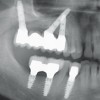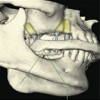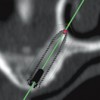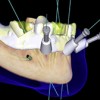Modern removable partial denture designs anticipate and accommodate the movement of the prosthesis during function so as to minimize the torquing forces delivered to the abutment teeth. The RPI, RPA and wrought wire RPD systems are discussed. Issues addressed include indications for use and the basic principles of design for each system. The principle focus is directed toward extension based removable partial dentures.
Removable Partial Dentures – Design Philosophies — Course Transcript
- 1. RPD Design Philosophies Ting Ling Chang, Takahiro Ogawa and John Beumer III Division of Advanced Prosthodontics, Biomaterials and Hospital Dentistry UCLA School of DentistryThis program of instruction is protected by copyright ©. No portion ofthis program of instruction may be reproduced, recorded or transferredby any means electronic, digital, photographic, mechanical etc., or byany information storage or retrieval system, without prior permission.
- 2. 6. RPD Design Philosophies RPI System (UCLA-Kratochvil) Mesial restRest Proximal plateProximal plate“I”-bar Tooth tissue junction “I” Bar
- 3. Types of Removable Partial DenturesTooth borne Abutment teeth border all edentulous areas Functional forces are transmitted through the abutments to bone It functions like a fixed partialdenture
- 4. Types of Removable Partial DenturesTooth borne Abutment teeth border all edentulous areas Functional forces are transmitted through the abutments to bone It functions like a fixed partial denture Parallel guide planes- proximal plates provide bracing and unite the arch
- 5. Types of Removable Partial DenturesTooth borne The removable partial denture should provide appropriate bracing ie. stability (resistance to lateral forces), and support for all the teeth remaining in the arch Ideally and when the occlusion permits rests should be extended into the middle of molar teeth
- 6. Types of Partial DenturesTooth borne Rests can be placed in any position as long as they direct occlusal forces along the long axis of the abutment tooth Exception: When distal abutment is suspect Stability, bracing and support should be maximized Virtually all of the support derived from the abutments
- 7. Types of Removable Partial Dentures Tooth-Mucosa borne (extension base) Exhibits one or more edentulous areas which are not bordered by abutment teeth Functional forces are shared by both the abutment teeth and denture bearing surfaces in the extension.
- 8. Types of Partial DenturesExtension base partial dentures Rest position contour critical to the design Support shared between the edentulous denture bearing surfaces and the abutments
- 9. RPD BiomechanicsExtension base RPD’s Distal extension RPD
- 10. Extension Based RPD’sChallenge Mucosal bearing surfaces are compressible. Therefore RPD’s are displaced and move during function. Designs must anticipate the movements of the RPD during function to prevent overload and loss of the abutments.
- 11. Extension Based RPD’sAmount of movement is dependent upon: The surface area of the mucosal support area The thickness and compressibility of the supporting mucosa The adaptation of the denture base to the tissues of the extension base Refinement of the occlusal factors (distal extension RPD’s) Anterior guidance – Centric only contact posteriorly
- 12. Types of Partial DenturesExtension base partial dentures Position of the rests determine axis of rotation (fulcrum line) The axis of rotation traverses through the most posterior portions of the rests adjacent to the edentulous area.
- 13. Extension Based RPD’s The rotation should be pure. There should be no contact with inclines of teeth that could change the axis of rotation and cause sliding action during occlusal function. The tips of the rests therefore must be contoured on the tooth as a half sphere (arrows) The proximal plates-minor connectors should not bind during rotation
- 14. Extension Based RPD’sPositioning the axis of rotation to idealize support in the edentulous area In this example when the rest is placed on the distal side of the abutment adjacent to the edentulous extension area the forces delivered are not vertical but almost horizontal in region just adjacent to the abutment Occlusal force Axis of rotation (rest)
- 15. Extension Based RPD’sPositioning the axis of rotation to provide the best support for the edentulous area Occlusal force Axis of rotation (rest) As a result little or no vertical support is obtained from edentulous area immediately distal to the abutment tooth
- 16. Extension Based RPD’sPositioning the axis of rotation to provide the best support for the edentulous area As you move the rest anteriorly the axis of rotation moves anteriorly, the arc of rotation becomes greater and the forces are directed more favorably in a more vertical direction in relation to the edentulous extension area Occlusal Occlusal force force
- 17. Extension Based RPD’sPositioning the axis of rotation to provide the best support for the edentulous area As you lower the rest and therefore the axis of rotation (for example by placing the rest on the cingulum of the cuspid) the forces are directed more favorably in a more vertical direction in relation to the edentulous extension area Occlusal force Axis of rotationTherefore it is advisable to lower the rotation point (the rest) whenever possible
- 18. Extension Based RPD’sDirect effect of rest placement on abutment teeth Open contact If the rest is placed on the distal of the tooth adjacent to the edentulous extension area, when a posterior force is applied the tooth is tipped towards the edentulous area, resulting in an open contact with the adjacent anterior tooth This tends to isolate the tooth making it more susceptible to bone loss and periodontal breakdown
- 19. Extension Based RPD’s Direct effect of rest placement on abutment teeth In this example when the rest is placed on the surface away from the edentulous extension area the force tends to move the tooth towards the adjacent tooth mesially Thus, the adjacent teeth anterior to the abutment absorbs some of the forces of occlusion. The remaining teeth function as a unit and as such help brace and stabilize each other during mastication
- 20. Extension Based RPD’s Design and positioning of the retainer The direction of retainer movement is determined by the location of the axis of rotation. Note the direction of movement of the retainers on both sides of the rotational axis (side A and side B)
- 21. Extension Based RPD’s Design and positioning of the retainer Positioning the retainer posterior to the rest produces a downward and forward movement of the retainer further into the undercut disengaging the retainer and preventing the tooth from being exposed to tipping forces
- 22. Extension Based RPD’s Design and positioning of the retainer If the axis of rotation is placed between the retainer and the edentulous extension area, the retainer moves upward, engaging and torquing the tooth when an occlusal force is applied in the edentulous extension area
- 23. Extension Based RPD’s Design and positioning of the retainer The retainer must not be placed behind the greatest curvature of the tooth in an extension base RPD because when an occlusal force is applied in the edentulous extension area, the retainer will be displaced anteriorly, torquing the tooth as shown (arrows).
- 24. Extension Based RPD’s Design and positioning of the retainer The retainer contact is placed at the greatest point of mesial-distal curvature of the tooth. The retainer will then disengage when an occlusal force is applied to the edentulous extension
- 25. Extension Based RPD’s Design and positioning of the retainer Rest position (mesial or distal) controls the axis of rotation, which in turn influences the direction of the movement of the retainer
- 26. Extension Based RPD’s Design and positioning of the retainer Retainers should not be placed in retentive (undercut) areas anterior to the axis of rotation In this example, if a retainer is placed on the cuspid (point A) in an undercut, when an occlusal forces is applied in the edentulous extension area, a lifting or extraction force will be applied to this tooth. The retainer should be placed on the height of contour
- 27. Extension Based RPD’s Movement of Proximal Plates and Minor Connectors When an occlusal force is applied to the edentulous extension area, in this example the proximal plates engaging the distal surfaces of the abutment, will engage the tooth surface, producing a torquing action. Moving the rest down and forward lessens this problem To avoid this problem, the RPD is “physiologically adjusted”
- 28. Extension Based RPD’s Movement of Proximal Plates and Minor Connectors When an occlusal force is applied to the edentulous extension area, in this example the minor connectors will engage distal surfaces of the tooth anterior to the abutment preventing pure rotation around the rests. To avoid this problem, the RPD is “physiologically adjusted”
- 29. Extension Based RPD’s Physiologic Adjustment A disclosing medium (gold rouge and chloroform) is applied to the undersurface of casting. Pressure is applied in the extension areas. As the casting rotates the rouge will be rubbed away from the casting. These areas are adjusted with a high speed hand piece until the casting freely rotates around the axis of rotation as designed without lifting.
- 30. RPI System -Posterior Extension Based RPD’s Summary Restore the integrity of the arch with guide planes – proximal plates Guide planes extend and cover the gingiva margin (tooth tissue junction) Rests should direct occlusal forces axially during function Rest on of the side of the tooth away from the edentulous extension area Retainers in undercuts must be designed to disengage under functional conditions Retainer on the teeth anterior to the fulcrum line should be placed on the height of contour, not in an undercut
- 31. RPI design principlesRest position On mesial side of tooth adjacent to distal extension defects On distal side of tooth adjacent to anterior extension defectsRetainer position Retentive portion of the retainer should not engage an undercut anterior to the axis of rotation From occlusal view, the retainer is placed at the point of greatest mesial- distal curvature of the tooth
- 32. Other RPD designsConventional Akers design – Distal rest with a cast circumferential retainer When an occlusal force in delivered in the edentulous extension area the RPD rotates around the distal rest, the retainer engages and the tooth and is tipped distally
- 33. Other RPD designsThe RPA system The rest is moved to the mesial. As a result, when an occlusal force is applied to the edentulous extension area, the tip of the retainer disengages by rotating further into the undercut The portion of the retainer above the height of contour is relieved. Otherwise this portion of the retainer will deliver a torquing force to the abutment tooth
- 34. Other RPD designs – The RPA system For the RPA system to work properly the retainer must not contact the tooth surfaces above the height of contour. When occlusal forces are applied in the extension area the tip of the retainer will disengage. Shim stock has been used to ensure that the portion of the retainer above has been properly relieved
- 35. Other RPD designs – RPA System Indications For Use Bulbous gingival contours Significant recession Lack of access for an I-bar clasp due to a shallow vestibuleSignificant periodontal recession Lack of vestibular depth for an I-bar
- 36. Other RPD designs – RPA System Indications For Use High frenum attachments Short teeth with poor or no guide planes and minimal undercuts Tilted teeth High frenum attachment Short tooth
- 37. Other RPD designsWrought Wire Circumferential Clasp (18 gauge wire) One can also use PGP (Platinum, Gold, Palladium) wire and solder it to frame- work prior to processing of the denture base.This type of retainer is very flexible and minimizes thetorquing of the abutment when an occlusal force isdelivered in the edentulous extension area.
- 38. RPD Design – Wrought Wire Retainers (Brudvik)RPI and RPA system using wrought wire Rests away from the extensions base On the mesial if distal extension On the distal if anterior extension base Altered cast impressions for extension bases Physiologic adjustment of RPD framework
- 39. RPD Design – Wrought Wire Retainers (Brudvik) Guides for its application: If the distance from its origin when it leaves the acrylic resin base is 7mm or less use PGP wrought wire clasp gauge # 20 If the distance from its origin when it leaves the acrylic resin base is greater than10mm use PGP wrought wire clasp gauge 18 For I-bar clasp: Use PGP wrought wire clasp gauge #19
- 40. Designing RPD’s Planning sequence for RPD patients Diagnostic assessment and preliminary impressions Diagnostic casts mounted in centric relation Draw the ideal RPD design (on paper) Survey the study casts and determine the most advantageous position (MAP) of the designed RPD path of insertion and withdrawal Revise and finalize the RPD design
- 41. Designing RPD’s Planning sequence for RPD patients Diagnostic assessment and preliminary impressions Diagnostic casts mounted in centric relation
- 42. Designing RPD’s Planning sequence for RPD patients Draw the ideal RPD design (on paper)
- 43. Survey the Cast Transfer the design to the study cast and determine the most advantageous position (MAP) for path of insertion and withdrawal and treatment position
- 44. Survey the Cast Determine the most advantageous position (MAP) of the designed RPD path of insertion and withdrawal and treatment position
- 45. Prepare guide planes and rests
- 46. Impressions and CastsSubmit to lab Detailed drawing of design on the study cast Detailed drawing of design on paper
- 47. Lab Prescriptions Good Design Prescriptions will have - Sharp, smooth outlines in identical color Design outlines proportionately drawn Bead seals clearly marked Retention areas indicated Guide plane tissue contacts marked Resin – metal finish lines clearly marked
- 48. Lab Prescriptions Good Design Prescriptions will have Sharp, smooth outlines in identical color Design outlines proportionately drawn Bead seals clearly marked Retention areas indicated Guide plane tissue contacts marked Resin – metal finish lines clearly marked
- 49. Visit ffofr.org for hundreds of additional lectures on Complete Dentures, Implant Dentistry, Removable Partial Dentures, Esthetic Dentistry and Maxillofacial Prosthetics. The lectures are free. Our objective is to create the best and most comprehensive online programs of instruction in Prosthodontics


 Restoration of Posterior Quadrants and Treatment Planning
Restoration of Posterior Quadrants and Treatment Planning
 Angled Implants
Angled Implants
 Prosthodontic Procedures and Complications
Prosthodontic Procedures and Complications
 Computer Guided Treatment Planning and Surgery
Computer Guided Treatment Planning and Surgery
